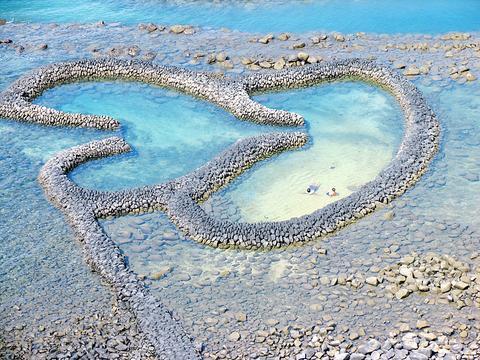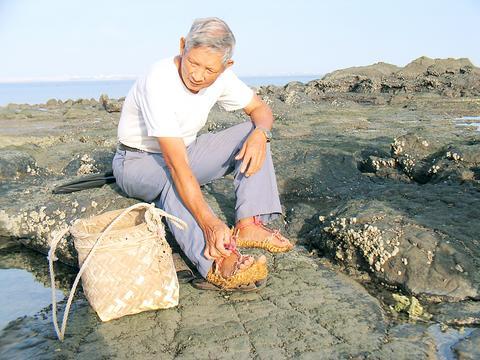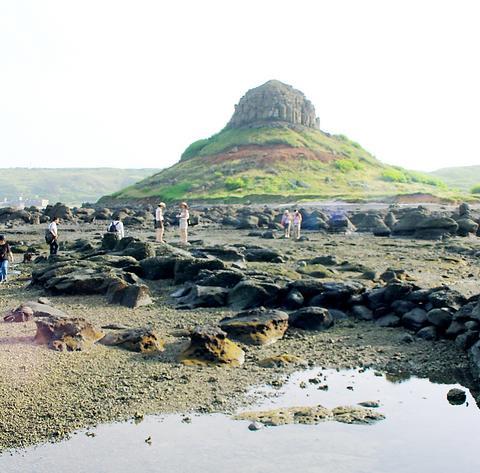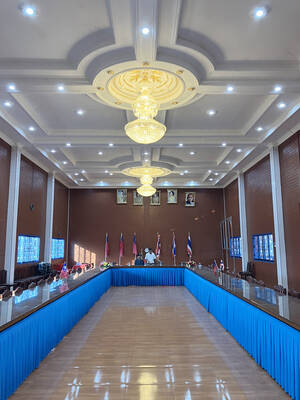Yang Chin-hua
Historians say stone weirs were first built in Penghu 700 years ago. The origins of most aren't known because they were public works; anyone in the community who could lift a rock and wanted to eat had incentive to help with construction. Because they eventually succumb to the tides, they have to be maintained.

PHOTOS: DAVID MOMPHARD, TAIPEI TIMES
But to call folks like Yang fishermen isn't entirely correct. Penghu's traditional lifestyle was equal time spent catching fish (often building a weir to catch more) and time spent coaxing crops out of infertile soil.

In farming, too, they built walls. On every island in the archipelago where crops have been cultivated, locals have stacked coral to protect their plants from the fierce winds that scour the archipelago in the winter months. Kilometers of meter-high walls crisscross the islands in a honeycomb pattern that is as pleasant to look at as it is practical.
But the stone weirs that trap fish have captured people's fancy, as well; none more than Twin Heart (

Yang's fish trap isn't the tourist trap that Twin Heart is. Mention Twin Heart, and he grimaces.
There are no young couples coming to photograph themselves in front of his fish trap -- there's no birds-eye vantage point from which to get it all in frame. And even if they could, no couple would want to be photographed in front of a fish trap called Cow's Heart (
Yang was out of luck in terms of materials to build his weir, too. Where Twin Heart sits beneath a cliff that has supplied an ample amount of basalt stones for its construction, Yang had to carry stones from the base of Turtle Mountain, a promontory of basalt rising 70m above sea level and hundreds of meters to the west. He used large pieces of coral in building it, as well, but said the heavier basalt didn't wash away as easily in the tide.
Yang started work on the project as a boy, helping his dad. A half-dozen able-bodied young locals who agreed to work for a share in the spoils joined them. The group piled stones by hand, one stone at a time, across an area the size of a football field. It took the better part of a decade.
How many fish does it catch in an average tide?
"Oh, maybe none. Not many," Yang said. "Fewer than it used to."
Though they've brought Yang his dinner all his life, the tides have slowly changed for Penghu. For the first half-century of Yang's life, his native Hsiyu was, in effect, more of an island than it is now. In the late 1970s, bridges connected it to Baisha and Matsu islands, making the three, in effect, one large island. About the same time, commercial air flights connected them to Taiwan proper. Then everyone left for paid work and a more modern lifestyle. Yang figures the folks that helped him stack his stone trap were among them.
"I haven't seen them here in a while," he said.

May 26 to June 1 When the Qing Dynasty first took control over many parts of Taiwan in 1684, it roughly continued the Kingdom of Tungning’s administrative borders (see below), setting up one prefecture and three counties. The actual area of control covered today’s Chiayi, Tainan and Kaohsiung. The administrative center was in Taiwan Prefecture, in today’s Tainan. But as Han settlement expanded and due to rebellions and other international incidents, the administrative units became more complex. By the time Taiwan became a province of the Qing in 1887, there were three prefectures, eleven counties, three subprefectures and one directly-administered prefecture, with

Taiwan Power Co (Taipower, 台電) and the New Taipei City Government in May last year agreed to allow the activation of a spent fuel storage facility for the Jinshan Nuclear Power Plant in Shihmen District (石門). The deal ended eleven years of legal wrangling. According to the Taipower announcement, the city government engaged in repeated delays, failing to approve water and soil conservation plans. Taipower said at the time that plans for another dry storage facility for the Guosheng Nuclear Power Plant in New Taipei City’s Wanli District (萬里) remained stuck in legal limbo. Later that year an agreement was reached

What does the Taiwan People’s Party (TPP) in the Huang Kuo-chang (黃國昌) era stand for? What sets it apart from their allies, the Chinese Nationalist Party (KMT)? With some shifts in tone and emphasis, the KMT’s stances have not changed significantly since the late 2000s and the era of former president Ma Ying-jeou (馬英九). The Democratic Progressive Party’s (DPP) current platform formed in the mid-2010s under the guidance of Tsai Ing-wen (蔡英文), and current President William Lai (賴清德) campaigned on continuity. Though their ideological stances may be a bit stale, they have the advantage of being broadly understood by the voters.

In a high-rise office building in Taipei’s government district, the primary agency for maintaining links to Thailand’s 108 Yunnan villages — which are home to a population of around 200,000 descendants of the Chinese Nationalist Party (KMT) armies stranded in Thailand following the Chinese Civil War — is the Overseas Community Affairs Council (OCAC). Established in China in 1926, the OCAC was born of a mandate to support Chinese education, culture and economic development in far flung Chinese diaspora communities, which, especially in southeast Asia, had underwritten the military insurgencies against the Qing Dynasty that led to the founding of